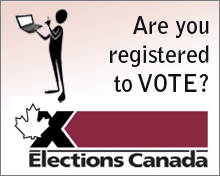The Trudeau Liberals have chosen to play a game of inches with electoral reform, tossing out plans to convert our system wholesale to a proportional representation model along with then-Minister of Democratic Institutions Maryam Monsef. They’ve since focused their efforts on trying to undo some of the changes introduced by the Harper Government in their 2013 Fair Elections Act.
Monsef’s Bill C-33, which now languishes on the order paper, would have reversed the provisions that made it illegal for electors to vouch for one another at a polling location, and the rule that declassified the Voter Identification Card (which voters get in the mail in advance of the vote) as a piece of ID that could be used to prove a voter’s identity. The latest attempt at legislation put forth by current Minister of Democratic Institutions Karina Gould, Bill C-76, contained these changes as well as expanded rules preventing foreign interests from influencing our elections, as well as measures that would make it easier for soldiers and the disabled to vote.
Lost in all this wrangling is the question of what issues the voters felt should be addressed, and whether or not the Trudeau government’s proposed changes matched up with those expressed concerns. That’s why we submitted an Access To Information request, requesting all complaints filed to Elections Canada in the wake of the 2015 federal election. As you might imagine, voters from all over the country voiced their displeasure about their voting experiences in both official languages, and we noticed a few recurring complaints popped up over and over again in the 3,675-page Access To Information return. Over the past few months, we sorted these complaints and tallied them, and we can now present our findings.
Based on what we read, the Trudeau government is on the right track with voters when it comes to allowing the Voter Identification Card as a piece of valid ID. 124 separate complaints mentioned that the VIC was not accepted as a form of ID, and 142 complaints made reference to the fact that the address on the card was different from the address on the ID that they were intending to vote with. Many of these voters did not understand why the card was being used at all, since it contained their address but could not be used to verify their identity.
There were 37 voter complaints about the voter card itself, specifically that the name on the card did not match the name on the voters list. Some of these complainants claimed that their name was crossed out on the list of voters when they arrived to vote, but there were so few as to be negligible. This was the only evidence of possible voter fraud that we could find.
Voters were less concerned with whether or not they were allowed to vouch for another voter than they were with whether or not the rules were being applied fairly. In fact, none of the complaints that we read actually referenced being prevented from vouching. Plenty of voters were able to attest for the identity of other voters whom they knew and who showed up to the polling station without proper ID. Six complaints did mention that voters were not being given the opportunity to attest for other voters, and a further seven asked why someone was able to attest for only one person.
By and large, however, the complainants raised issues that would be in no way addressed by the Trudeau government reforms. As we alluded to in the previous paragraph, the largest percentage of voter complaints concerned the conduct and competency of Elections Canada staff, hired to manage the polling stations on Election Day.
In 35 complaints alone, voters were not asked for their ID at all, but 24 complaints made reference to being asked for ID multiple times. 78 voter responses made reference to general rudeness on the part of Elections Canada staff. At times the complaints did not elaborate on what they meant by “rudeness”, but those that did described defensive behaviour, visible frustration and anger, or disinterest on the part of those people managing the poll stations.
Voters were far more descriptive when it came to pointing out the gaps in the poll clerks’ knowledge. It was common (104 complaints) for these workers to insist that picture ID was a requirement to vote, when in fact, it was not. 288 complainants referenced being inconvenienced or turned away because their IDs lacked an address, although another large group of complainants (159 people) were upset that they could not use their passport as ID, even though it contained a photo and their address. 269 complainants reported that the staff refused either a driver’s license or health card as a valid form of ID because the card in question lacked a photo, or had an older or incorrect address. Frequently, the voters would make reference to their age, with students emphasizing that this was their first election and that it negatively affected their perception of the voting process, while seniors would talk about how many elections they had participated in with this being the worst experience yet. 47 complainants were made to wait for 40 minutes or longer to vote, due to staffing shortages, confusion on how to apply the rules, or debates over what constitutes proper ID.
Some voters noticed that it made little sense for polling officials to accept a phone bill (for example) but not a Canadian passport as acceptable ID. Others would talk about correcting the poll workers by bringing up the EC rules for what constituted acceptable ID on their phone or referring to posters posted at the location. Others only realized that they had been incorrectly turned away after they got home and accessed the website.
The package from Elections Canada also contained some incident reports that featured the perspectives of the staff that worked there. These reports referenced 24 instances of voters tearing up and throwing their voter card away, while 106 of these reports referenced voters who swore, yelled or made a scene in the polling station.
One troubling trend that we noticed is that people who were turned away due to lack of or improper ID were much more likely to complain about how voters wearing face coverings were (apparently) allowed to vote without showing their face. (In reality, as confirmed by some of the form letters contained in the package, voters wearing face coverings were supposed to remove their garments in a secluded room before they were allowed to vote). 169 separate complaints referenced the niqab or other face coverings. Some were from voters who were veiled who complained about election workers making derogatory remarks about face coverings, while a small number of veiled voters actually complained that they were not asked to take off their face covering. Two voters who wore a motorcycle helmet complained that he was not asked to remove his gear, while one or two referenced voters actually wearing bags over their heads as a form of protest.
The vast majority of complaints concerning the niqab were in French, and 32 of them used the same pre-written form letter containing 5 reasons why the niqab was incompatible with Western values. There were 9 references to Rebel Media-backed domain “showyourface.com”, and two references to a Facebook post where Muslim voters were encouraged to wear a niqab into polling stations and vote multiple times for Justin Trudeau. No complaints mentioned the effect of foreign funding affecting the election.
If these complaints are anything to go by, the risk of voter fraud appears to be very low in Canadian elections, and most of the complaints describe annoyances and inconsistencies in applying rules. However, these inconsistencies are leading to a sense among some complainants that some voters — particularly Muslim voters who wear face coverings — are jumping the queue. The Trudeau government would do well to train poll workers to do their jobs better, and ensure that a situation where Elections Canada are scrambling to fill positions before the next election does not occur again, which unfortunately was the case days before last June’s Ontario election.
The 3,675-page ATI return can be found here.


Very interesting–great effort! As a comment on the last paragraph remarks about training poll clerks; I was a poll clerk in the 20165 election–during the training I noticed that the Deputy Returning Officer was totally useless so I contacted elections Canada and warned them in no uncertain terms. Nothing was done and sure enough this DRO was a disaster–she did zero preparation and had even left all the supplies and ballots in her daughter’s car–who on election day drove that car somewhere else. Chaos ensued but the ballots were retrieved in time. So clearly Elections Canada was lacking–but also it reveals a certain attitude some people have: that the Government is a cash cow and a Govt job is free money with no actual work. Sure some people are just lazy, but in part it is a “message” the “welfare state” sends out, and snowflake politics such as Trudeau is promoting is NOT going to encourage anyone to be more responsible.
LikeLike